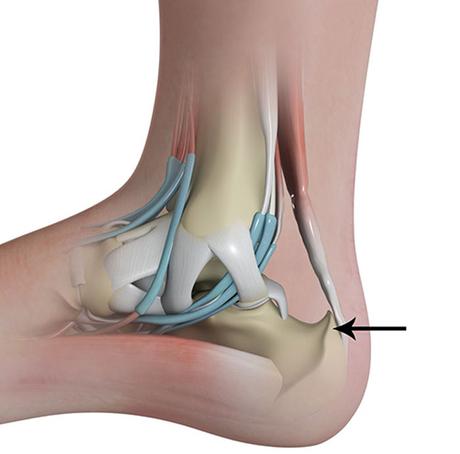Haglund’s deformity is a bony enlargement on the back of the heel. The soft tissue near the Achilles tendon irritates when the skeletal growth rubs against the shoes. This often leads to painful bursitis, an inflammation of the bursa (a fluid-filled sac between the tendon and bone).
Calcium can build up in the heel bone when the heel becomes inflamed. This makes the bump more significant and increases your pain.

Haglund’s deformity is often called “pump bump” because the rigid backs of pump-style shoes can create pressure that aggravates the enlargement when walking. Any shoes with a stiff back, such as ice skates, men’s dress shoes or women’s pumps, can cause this irritation.
Bursitis is an inflammation of the fluid-filled sac between the tendon and the bone. Calcium can build up in the heel bone when the heel becomes inflamed. This makes the bump more significant and increases your pain.
Do you have pain at the back of your heel while wearing a shoe?
This could be a pump bump or Haglund’s deformity.
This is pain on the back of your heel.
And we’ll show you how to fix it safely and skip the surgery.
Haglund's Deformity
A Haglund’s deformity could be a few things. It’s usually a significant buildup of the heel, so when you’re walking, it’s rubbing against the back of the heel.
This could be in high heels, it could be in shoes, and it could be Retrocalcaneal bursitis.
So this could be soft tissue swelling at the back of your heel. That’s a prevalent cause.
So it could be your Achilles tendon insertion, it could be bone, it could be the soft tissue.
All three are very common, even number four, a heel spur.
So all of these can cause back of the heel pain.
But don’t worry; this treatment guide will help you handle all four problems, so we’ve got you covered for all four.
So this is sometimes known as a pump bump because it can irritate you in high-heeled shoes. But it’s not quite a spur.
It’s for people with a big, prominent bone that rubs.
For most people, it’s not just the bone; it’s the actual twisting.
So when you walk, and your foot turns out, that heel twists and rubs on the outside in the back of your shoe.
This is what bothers the back of your heel.
This then causes the tissue to swell in the back, and it causes your Achilles tendon to hurt in the back. All of these contribute to each other.
So the four problems are all related, and a Haglund bump is one of the most prevalent causes.
You may also be more at risk for getting Haglund’s deformity if you have a high foot arch, have a tight Achilles tendon, or tend to walk on the outside of your heel.

Diagnosis of Haglund's Deformity
An orthopedic specialist or GP is the best medical practitioner to seek advice from when suspecting Haglund’s deformity Syndrome.
A thorough physical check and patient history help understand the risk factors individually.
Sophisticated imaging technology like X-rays can be used to determine the location and progression of the bone growths in the affected area.
Together this information can help form an effective prognosis.
Postural Dysfunction Scoliosis What Is Clubfoot and How to Treat it?Treatment For Haglund's Deformity & Haglund's Bump
Here’s how you want to start treatment of Haglund’s Deformity & Haglund’s Bump. You can put some pegs on for fifth toe joint pain, bunion pain, and hammer toe pain.
You set these up, and you can stretch out that front to see the correlates to those areas.
And when you put it in the shoe, it can stretch out the front and heel of your shoe.
So this is a multi-use device, but we’re primarily interested in the heel. So let’s get it in there.
And see, you have that back stopper.
So by twisting it up front, it’ll stretch out the show for you.
So many people with heel pain might also need this, but as we’re getting the pressure off those areas, let’s look at the heel.
You stick it on there, and you extend the heel. So, for your bump in the back, that stretches it out. And it can stretch out the top right there.
Such a great multipurpose tool. And what you want to buy is a shoe spray. And what that does right there is you spray it on there. It takes 24 hours to solidify. But you get that on that heel, and your heel is less likely to rub.
This can work on almost all shoe materials, but be safe.
Don’t ruin your shoe by going too crazy. You want good shoes. So it should only really bend in the toe, but a firmer shoe.
If you can take your shoe and bend it into a V, that’s not a good supportive shoe.
And this is for slippers as well at home.
And then you want to get an insert.
So a couple of things right here that the insert does is, number one, your heel sits slightly higher.
So it gives you a little bit of a lift.
Lifting it a couple of millimetres for heel spur and Achilles tendonitis sometimes makes all the difference. And number two, here’s what it does.
When you walk, your foot twists.

So what’s happening in the back of your heel is rubbing and twisting on the back.
In an orthotic, not only is it lifted, but it’s not twisting. It just moves straight up and down like this—no heel twist.
That’s the natural beauty of the orthotic with this condition. Physiotherapy, just like stretching at home, works great.
Get your hips, your hamstrings, and your calf muscles checked out. Stretch all these muscles out. It will help you walk much more quickly.
So as you ice and take anti-inflammatories, all that pain will decrease. It can work well in surgery, heel spur surgery, and Haglund bump surgery.
So essentially, what happens is there’s a way to shave down the heel bone.
The problem is your Achilles tendon attaches here.
So you have to detach the Achilles tendon. You have to shave the bone with a bone saw, and then you have to put that back.
Do these work great?
They work great. So if you have an extensive heel spur, it works well. Here’s the big problem. You’re in a cast; for me, it’s six weeks. Then you’re in a walking boot for six more weeks.
And we generally have to lengthen your Achilles tendon at the same time. If you can do this by stretching, we highly recommend doing that ahead of time.

